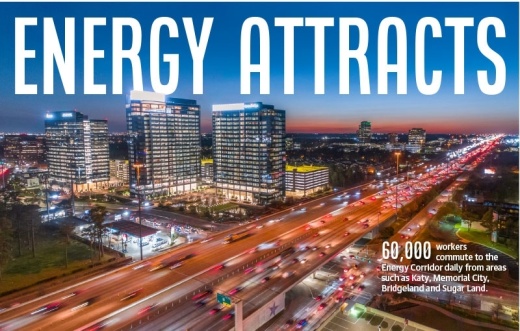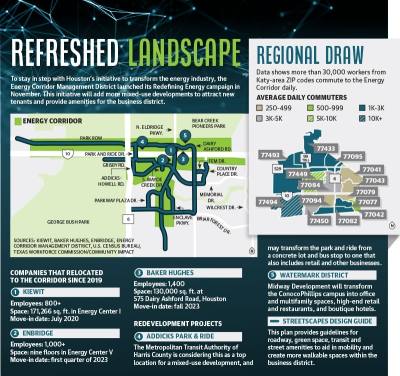Now, a rebrand launched in November aims to position the corridor to lead Houston’s push toward clean energy and cater to a post-pandemic workforce, officials said.
The Redefining Energy rebrand campaign is led by the Energy Corridor Management District, which funds various maintenance and beautification projects in the corridor, including infrastructure improvements, public safety and security, and transportation and mobility.
The rebrand will invest in projects to accommodate workers with hybrid schedules and attract tenants outside of the oil and gas industry to maintain the Energy Corridor’s position as a critical economic hub, said Elijah Williams, executive director of the management district.
“Employees have to eat; they need dry cleaners and coffee places, they need services with beauticians and dentists, they need places to stay—it all has an effect that is tied to the job opportunities located here in the Energy Corridor,” Williams said.
Moreover, many people who work in the Energy Corridor live in the surrounding suburban area; 2022 data from the Texas Workforce Commission showed more than 30,000 Katy-area residents work in the corridor.
Notable tenants
The Energy Corridor is composed of office space, dining and retail, and parks and open space. It is also home to various industries, and its largest employers include American Petroleum Institute, MD Anderson West Houston, Shell and Baker Hughes—the most recent of six Fortune 500 companies to relocate to the district.
Larger corporations find West Houston areas such as the Energy Corridor more attractive because it is where their employees live, said Ryan Barbles, managing director for Stream Realty Partners’ Houston division. Stream Realty, a commercial real estate developer, leases and manages a handful of properties in the Energy Corridor.
Additionally, suburban workplaces also help companies add density to their workforce by increasing the number of employees, he said.
“In theory, companies move out of downtown so they can get denser,” Barbles said. “Parking ratios are bigger, they can hire more people [and] fit more bodies in a building versus downtown [Houston].”
Baker Hughes will begin relocating its headquarters from near George Bush Intercontinental Airport to 575 Dairy Ashford Road in late fall or winter 2023, a Baker Hughes spokesperson said. The spokesperson said the company was attracted to the concentration of oil and gas companies in the district, which brings them closer to its major customers, and the amenities the district offers its employees.
Meanwhile, Canada-based energy infrastructure organization Enbridge subleased floors of the Energy Center V office building in March 2022. The relocation from its Galleria-area offices occurred in stages and concluded early this year, company spokesperson Michael Barnes said.
Data from the fourth quarter of 2022 showed there was 34.87 million square feet of total inventory for office space in the Katy Freeway submarket, according to a report from Colliers, a commercial real estate company.
Colliers data for the Katy Freeway submarket—which includes business districts along I-10 such as the Energy Corridor, Katy, Memorial City and City Centre—showed a 20.1% office vacancy rate. However, this is lower than the West Loop, Galleria and Westchase submarkets.
Despite this, Williams said the Energy Corridor’s post-pandemic story has mostly been a positive one.
“We have a strong economic base with some long-term corporate presence, and that represents a good bit of stability for the area,” he said.
Reimagining the workforce
One of the largest influences of the pandemic has been the re-evaluation of how people work, Williams said. With hybrid schedules, he said companies do not require the same level of office space as before the pandemic.
“There will be some level of work from home [and] some level of a hybrid schedule that happens, but I think companies are still looking to be back into the office to support innovation and collaboration,” he said.
Deanna Jones, chief human resources officer for Baker Hughes, wrote in a summer 2022 email to the company’s Houston employees the move to the Energy Corridor is part of the company’s cultural and operating journey it started in 2020.
The transition aims to minimize costs and promote workplace flexibility, Jones wrote. Comments from the company’s spokesperson said it also provides Baker Hughes with a competitive advantage by supporting a flexible and remote work policy.
Ramit Plushnick-Masti, the Energy Corridor’s communications and marketing manager, said many organizations are considering similar strategies to support a changing workplace landscape.
“In a post-pandemic world with a tight labor market, employers are looking to decrease the commute to their workers,” Plushnick-Masti said. “So if everybody is living in Katy, moving your office here makes your people very happy.”
Corridor initiatives
Further affirming a hybrid workforce are several ongoing initiatives within the Energy Corridor that are resident-facing.
Projects out of the management district’s Redefining Energy campaign aim to create connectivity, broaden the scope of energy as more than oil and gas, and help the business district lead the energy transition happening in Houston, Williams said.
“Quite frankly, energy is anything you want it to be,” he said. “So if you want that to mean health care, if you want it to mean food, it can be that.”
Midway Development announced the mixed-use Watermark District at Woodcreek development in October, with plans to begin construction in the first half of 2023. The project will reimagine a 70-acre site by converting the old ConocoPhillips campus at North Dairy Ashford to office space, multifamily housing, retail, restaurants, a hotel and after-hours entertainment, officials said.
The public relations officer for Midway declined to share an anticipated end date for construction, but the initial news release states the development firm will preserve the low-rise, low-density work environment and landscape that is attractive to a post-pandemic workforce.
Additionally, the Energy Corridor Management District also intends to tackle projects this year outlined in the Energy Corridor’s Streetscape Design Guide, released in March 2022. The goal of the guide is to maintain the corridor as a hub for mixed-use development, promote multimodal access, and revitalize streets to be safe and walkable, per plan documents.
This includes connecting corridor roads to create an integral multimodal system, such as Park Row, Eldridge Parkway, Memorial Drive, Dairy Ashford Road and Briar Forest Drive. One planned project will add shade trees, public plazas and pocket parks, consistent pedestrian lighting, bike infrastructure, adjusted travel lanes, and clearly defined parking to Grisby Road.
The management district is also working on an economic impact report, a mobility plan and a comprehensive study—which will be released in mid- to late 2023, Williams said.
“Houston is on this quest to become the energy transition capital of the world, and the headquarters of that capital is the Energy Corridor,” Plushnik-Masti said. “So it is incumbent on us, from a city standpoint, from a district standpoint, to tell that story so that we’re also helping the industry lead that innovation.”






